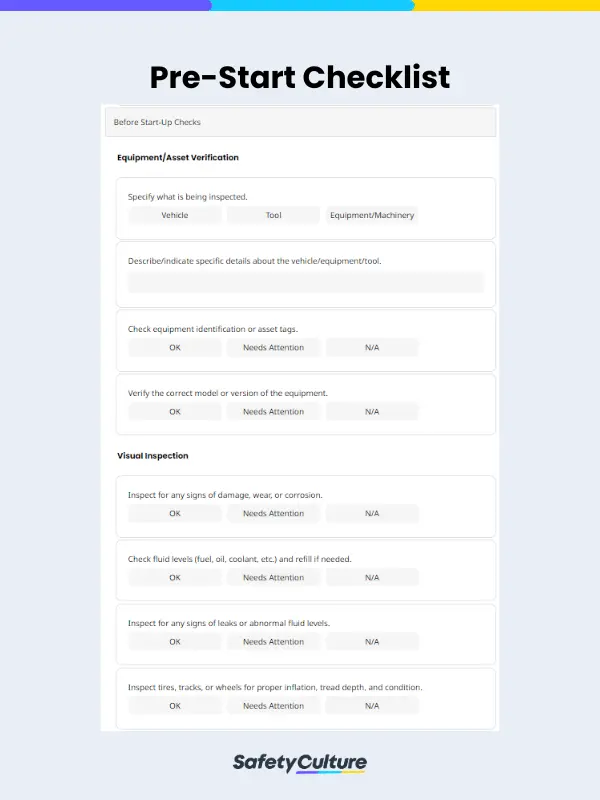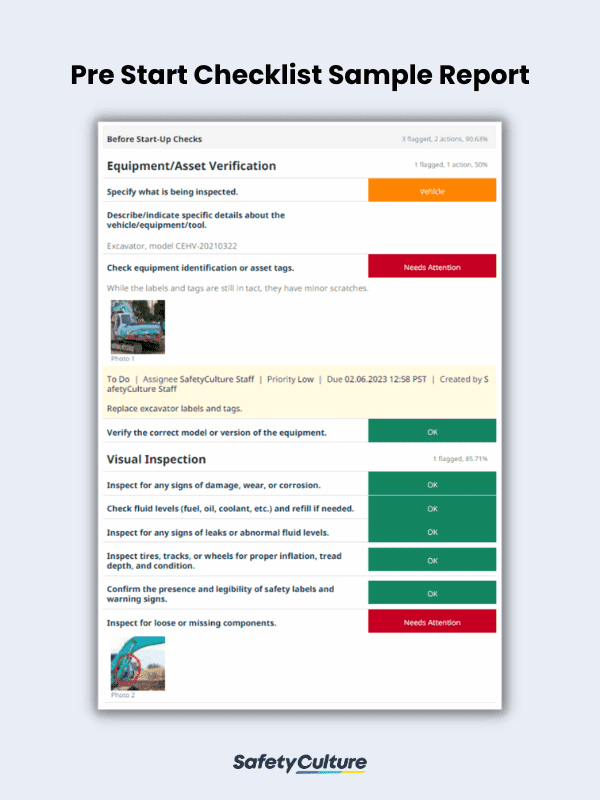What is a Pre Start Checklist?
A pre-start checklist is a tool used to list tasks or items needing to be completed or verified before starting a particular activity, process, or operation. It’s commonly used in various industries, such as construction, manufacturing, and logistics, to ensure that all necessary preparations have been made and that everything is in proper and safe working order before proceeding.
What are the 4 Steps in a Pre Start Check?
To help identify and mitigate potential risks, ensure that equipment or systems are in proper working order, and establish a standardized procedure for pre-start checks, make sure to follow these 4 steps:
- Inspect the equipment, vehicle, or system thoroughly to identify any visible damage, wear and tear, or potential issues. This includes checking the overall condition, components, fluids, and safety features.
- Verify the presence and functionality of critical elements necessary for safe and efficient operation. This may involve confirming the availability of required tools, checking fluid levels, inspecting safety guards, and testing emergency stop functionality.
- Ensure that all necessary preparations have been made before starting the activity or operation. This step involves reviewing plans, obtaining permits or licenses, communicating details to stakeholders, and ensuring that team members are aware of their roles and responsibilities.
- Complete any required documentation, paperwork, or checklists associated with the pre-start check. This includes recording the results of the inspection, documenting completed tasks, and maintaining relevant records for future reference or compliance purposes.
Purpose and Benefits of Using Pre Start Checklists
The purpose of a pre-start checklist is to enhance safety, efficiency, and effectiveness by systematically addressing critical elements or potential risks associated with the task at hand. Also, using a checklist when conducting pre-start checks lets you achieve the following benefits:
- Consistency – helps establish a standardized procedure, ensuring that all critical elements are addressed and that no steps are missed
- Safety – guides operators in systematically inspecting safety features, verifying emergency functionalities, and ensuring that all necessary precautions are taken
- Compliance – ensures that all required tasks and inspections are completed, documentation is properly maintained, and compliance with relevant regulations is achieved
- Efficiency – provides a clear and structured approach to pre-start checks
- Recordkeeping – serves as a documented record of completed pre-start checks by providing a comprehensive history of inspections, maintenance activities, and any identified issues or concerns
- Continuous Improvement – assists organizations in identifying areas for improvement, refining their processes, and implementing necessary changes
- Reduced Downtime – helps identify and rectify potential risks or faults before a catastrophic fail
What to Include in a Pre Start Checklist
The content of a pre-start checklist can vary depending on the specific requirements of your equipment, industry, and operation. Generally, here are some of the most common items to include when you’re aiming to inspect a tangible asset before using it:
- Title Page:
- Audit Title
- Client/Site
- Date, Time, Location, and Person in Charge of the Pre-start Check
- Before Start-Up Checks:
- Equipment/Asset Verification
- Visual Inspection
- Supplies/Materials
- Safety
- Communication
- Environment and Surroundings
- Documentation and Permits
- Training
- After Start-Up Checks:
- Functional Tests
- Completion Page:
- Notes/Recommendations
- Operator’s Name and Signature
How to Create One
Creating a pre-start checklist involves several steps to ensure its effectiveness and relevance to your needs. Here’s a guide on how to create one for your organization:
- Determine the specific purpose of the pre-start checklist. Is it for equipment inspection, vehicle readiness, safety checks, or a combination of factors? Clarifying the purpose will help you define the scope and focus.
- Make a comprehensive list of critical items that need to be checked before starting the activity or operation. Consider elements such as equipment condition, safety features, fluids, controls, documentation, and environmental factors. You can check the operator manual to access this information.
- Group related items together under appropriate categories. This helps organize the checklist and makes it easier to follow during the actual pre-start check.
- For each item on the checklist, define specific checkpoints or actions that need to be taken. Be clear and concise in describing what needs to be inspected, verified, or tested.
- Determine which items on the checklist are of utmost importance or have higher safety implications. Place these items at the top of the checklist to ensure they receive adequate attention during the pre-start check.
- Arrange the items on the checklist in a logical and sequential order that aligns with the typical flow of the pre-start check. Start with general verifications, move on to specific inspections, and end with functional tests or documentation requirements.
How to Use a Pre-Start Checklist
Using a pre-start checklist involves following a systematic approach to ensure that all required checks and inspections are conducted before starting an activity or operating equipment. Here’s a step-by-step guide on how to use a pre-start checklist effectively:
- Familiarize yourself with the checklist to understand its structure, items, and instructions.
- Prepare the checklist and required tools specific to the equipment or activity you’re about to undertake.
- Perform a visual inspection to identify any obvious signs of damage, wear, or abnormalities.
- Verify equipment readiness, including its critical components, safety features, controls, and indicators to ensure they are in proper working condition.
- Conduct functional tests (if applicable) to ensure that it operates correctly and meets the required performance criteria.
- Document your findings and the actions taken.
- Keep a copy of the completed pre-start checklist for your records or as required by your organization’s procedures.
What are Other Examples of Pre Start Checklists?
A machinery pre-start checklist may include items like the following:
- Verify that all safety guards are in place.
- Check fluid levels (oil, fuel, coolant, etc.).
- Inspect for any signs of damage or wear.
- Test emergency stop functionality.
- Confirm that all required tools are available.
- Review and understand the operating manual or instructions.
- Check for any warning lights or error messages.
In other contexts, such as project management or event planning, the following are the steps to be taken and items to be included:
- Confirm that all necessary permits or licenses are obtained.
- Double-check the availability of required resources (personnel, materials, etc.).
- Review the project plan or event schedule.
- Check that all stakeholders are informed and aligned.
- Verify that any required documentation or paperwork is completed.
- Conduct a final risk assessment or safety briefing.
- Ensure that all team members are aware of their roles and responsibilities.
FAQs About Pre Start Checklists
Industries such as construction, manufacturing, transportation, aviation, and healthcare often have specific regulations or standards that outline the need for pre-start checks and associated documentation. These regulations aim to prevent accidents, minimize risks, and ensure equipment or systems are in proper working order before they are put into operation.
Furthermore, organizations may have internal policies and procedures that require the use of pre-start checklists as part of their safety and operational protocols. Employers and businesses may implement such policies to maintain a consistent approach to pre-start checks, reduce liabilities, and meet their duty of care obligations towards their employees, customers, and the environment.
Pre-start activities focus on inspecting and ensuring the readiness of equipment, vehicles, machinery, or systems before operation, while toolbox talks are group discussions that cover various safety topics and promote safety awareness among workers. While they’re different in nature and serve unique purposes, both practices play important roles in maintaining a safe working environment.
Integrating pre-start checklists into daily operations requires careful planning and implementation to ensure their effectiveness and adherence to set standards. Here are some steps to follow:
- Develop a standard procedure for conducting pre-start checks and ensure consistency across all operations.
- Create pre-start checklists that are specific to the equipment, vehicles, or systems used in your organization.
- Train all personnel involved in the pre-start checks on the purpose, procedures, and importance of using the checklists.
- Make the pre-start checklists easily accessible to all personnel who need to perform them.
- Integrate the pre-start checks into the daily routine and work schedule of operators and maintenance personnel.
- Regularly monitor and assess compliance with the pre-start checklists.
- Continuously review and improve the pre-start checklists based on feedback, lessons learned, and changes in equipment or operational requirements.
- Promote a strong safety culture within the organization by emphasizing the importance of pre-start checks and adherence to the checklists.



